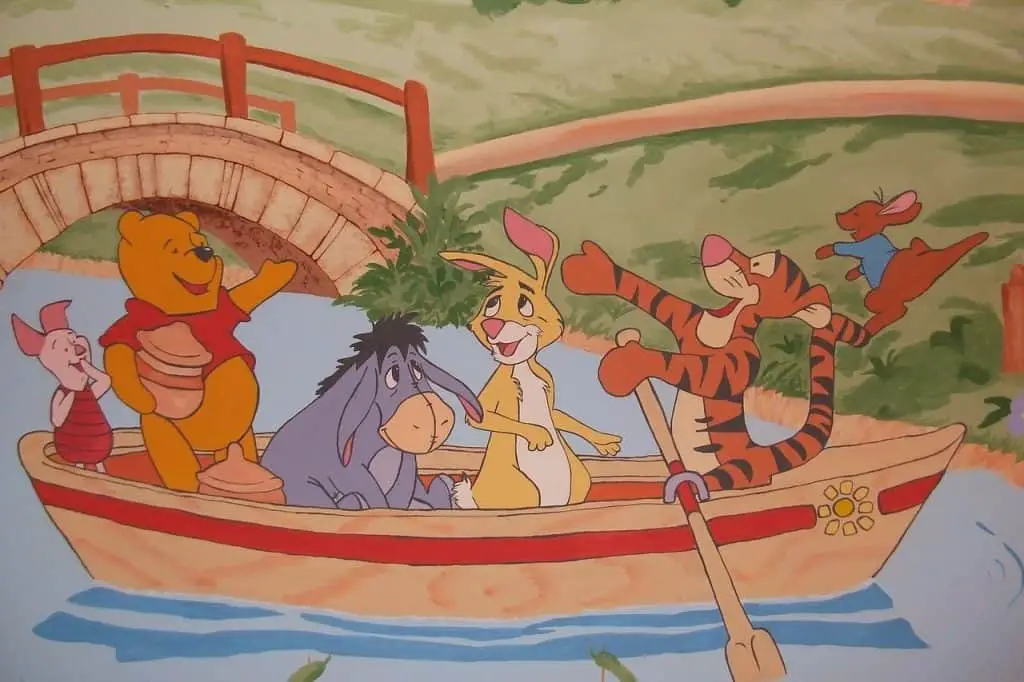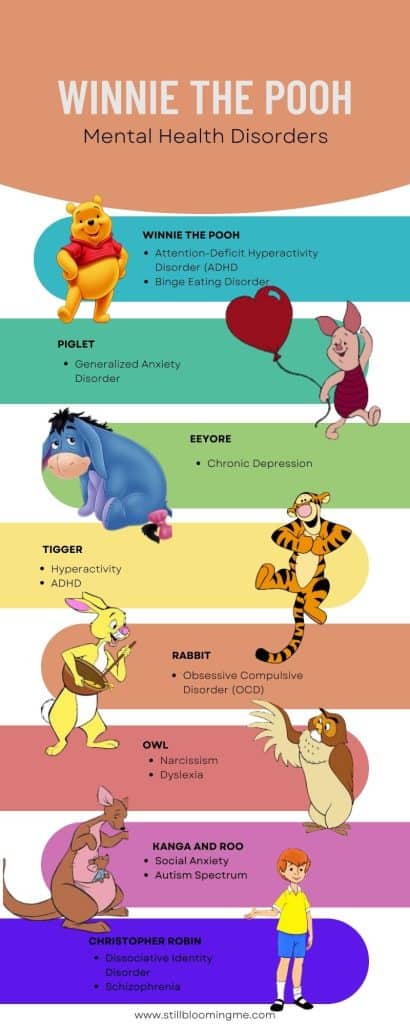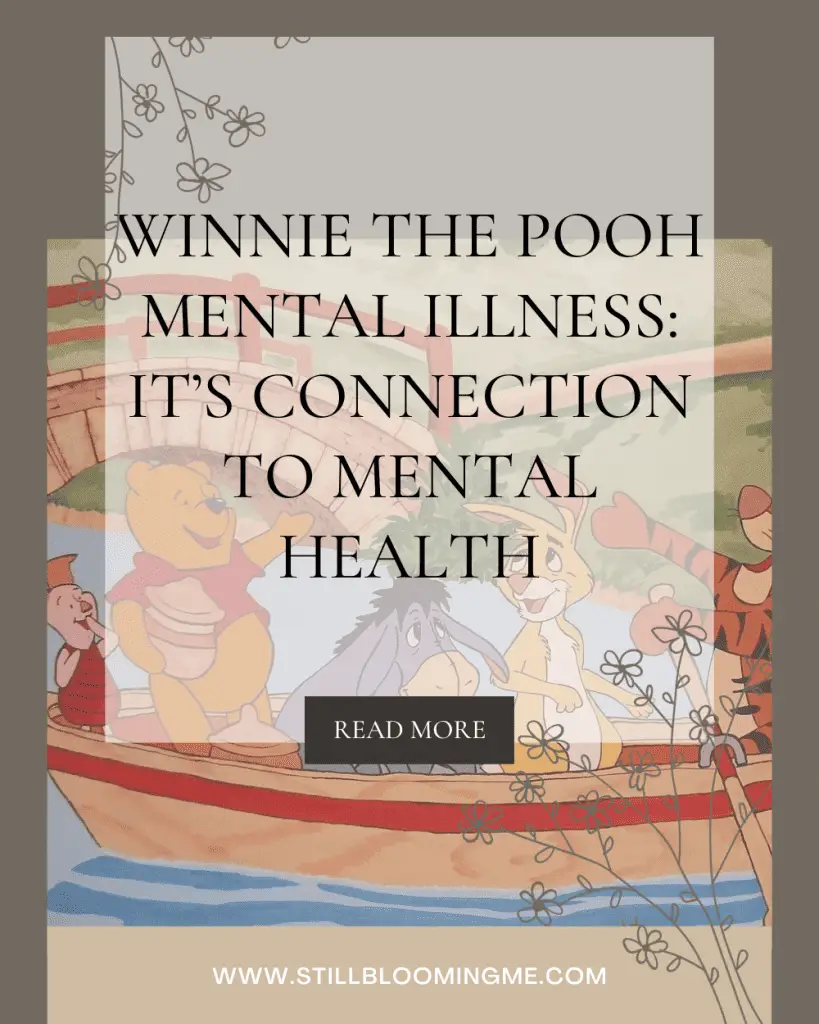Table of Contents
ToggleWinnie the Pooh Mental Illness: It’s Connection to Mental Health
Have you ever considered that Winnie the Pooh and his friends were displaying symptoms of mental illness?
I watched Winnie the Pooh for years as a child with my sisters, one of which is now a professor of developmental psychology, and this concept was completely new for both of us!
But this theory isn’t new! According to a research paper in the Canadian Medical Association Journal, titled Pathology in the Hundred Acre Wood: a neurodevelopmental perspective on A.A. Milne , Sarah E. Shea, Kevin Gordin, Ann Hawkins, Janet Kawchuk, and Donna Smith, uncover what greater themes are being shared through these loveable characters in the Hundred Acre Woods and its really fascinating.
In both the books by A.A. Milne and the subsequent Disney adaptations, many people have noted that the inhabitants of the Hundred Acre Wood exhibit behaviors and characteristics that are strikingly similar to various mental health conditions. I think the connection offers a unique lens through which to understand mental health in a familiar and non-threatening context, especially for children.
As you explore the personalities and quirks of Pooh and his friends, you may find that Pooh himself exhibits signs of Attention Deficit Hyperactivity Disorder (ADHD) due to his forgetfulness and focus issues. Or that his perpetual quest for honey indicates an obsessive fixation, aligning with behaviors typically associated with Obsessive-Compulsive Disorder (OCD). By examining these characters from a mental health perspective, we uncover ways to destigmatize and promote discussion around mental illnesses.
This exercise is not intended to trivialize the experiences of individuals living with mental illness. It’s meant to encourage a deeper understanding of both human psychology and the richness of literature, whether you are a mental health professional, a literary enthusiast, or simply a fan of the stories of Winnie the Pooh and his friends.
The Characters of Winnie the Pooh and Mental Illness
Introduction to the main characters
You know them by Winnie, Piglet, Eeyore, Tigger, Rabbit, Owl, Kanga and Roo and Christopher Robin, but do you know their mental illness traits?
Let’s break down their behaviors and analyze their potential metal health issues.
Winnie the Pooh
Winnie the Pooh, affectionately known as Pooh Bear, demonstrates signs of Attention Deficit Hyperactivity Disorder (ADHD). He’s distracted, loses his train of thought consistently, loses track of time, and has a short attention span. Additionally, Pooh is fixated on his mission to find and eat honey. It’s loveable yes, but could signal obsessive compulsive disorder (OCD) and binge eating disorder.
Piglet
Piglet displays behaviors consistent with Generalized Anxiety Disorder (GAD). Poor Piglet is always worried about something! His concern about the small possibilities of danger that might befall him and constant nervous demeaner signal that this little guy is struggling. He’s always waiting for the heffalumps and woozles to snatch him!
Eeyore
Oh Eeyore! The poor donkey always searching for his lost tail and more notably his gloomy and depressive mood, which could reflect symptoms of chronic depression. He is often downcast and exhibits a negative outlook on life, a poignant portrayal of this mental health challenge.
Tigger
Tigger, known for his boundless energy and propensity to act on whims, which might be indicative of Hyperactivity and ADHD. His restlessness and lack of concern for consequences or danger mirror aspects of impulsivity.
Rabbit
Rabbit is often portrayed as a perfectionist with tendencies toward being excessively orderly and controlling, traits that can suggest symptoms of Obsessive-Compulsive Disorder (OCD), particularly when his plans are disrupted causing him significant stress.
Owl
The character of Owl is portrayed as wise and knowledgeable, but he can also be seen as having a degree of narcissism, demonstrating an overly inflated sense of his own wisdom and importance. He also has difficulty reading words correctly which could signal dyslexia.
Kanga and Roo
Kanga is a nurturing figure, but sometimes demonstrates an overprotective parent. She also exhibits social anxiety. While Roo, her offspring, symbolizes the innocence and playfulness of childhood and as Tigger’s closest friend, could fall victim to little structure and stability. Roo also shifts between the safety and security of his mother’s pouch and the lack of awareness and impulsivity he demonstrates in the outside world pointing to being on the autism spectrum.
Christopher Robin
Christopher Robin may seem like a child with a wonderful imagination or is there something else going on? He is of course living presently in two worlds, the Hundred Acre Wood, his own creation, and the real world. His personality traits point to Dissociative Identity Disorder. Or could this world and these characters that Christopher speaks to and plays with be signs of something like schizophrenia?
How the characters represent various aspects of mental health
Each character in the Winnie the Pooh series may be interpreted to mirror real human behaviors and mental illness conditions, providing a platform to discuss and understand mental health in a more accessible way. Their personifications offer a unique lens through which you might view various psychological conditions.
Exploration of the Hundred Acre Wood as a metaphor for the mind
The Hundred Acre Wood, where you find Pooh and his friends, often serves as a larger metaphor for the mental landscape. Each location within the Wood symbolizes aspects of psychological well-being or challenges, inviting you to reflect on the complexity of your own mental spaces. For example;
- Owl’s House: Represents wisdom and knowledge, a place where rational thought is valued.
- Eeyore’s Gloomy Place: A metaphor for depression or low mood, illustrating how these feelings can isolate a character. Even his house is a sad little tent structure made of sticks!
- Pooh’s Thoughtful Spot: The place for contemplation, signifying the importance of taking time to reflect.
The role of resilience, friendship, and coping mechanisms
Within the stories of Pooh and his friends, you observe resilience, friendship, and coping mechanisms as central themes that offer solace and recovery from mental stress.
Resilience: The manner in which characters bounce back from adversity, such as Pooh’s constant pursuit of honey regardless of obstacles.
Friendship: A consistent source of support, as seen when friends rally around Eeyore on his birthday.
Coping Mechanisms:
-
- Pooh: Uses creativity and rhyme to cope with fear during his ‘Expotitions’.
- Piglet: Relies on his friends’ reassurance to manage his anxiety.
Understanding these psychological themes in “Winnie the Pooh” provides a lens to explore mental health in a context that is accessible and relatable.
A.A. Milne: The Creator’s Influence
Background on A.A. Milne’s life and experiences
A.A. Milne was born in London in 1882. Before he became a successful author, he served as a soldier during World War I. This period of service deeply impacted Milne, leading to a post-war desire for peace and simplicity, which is echoed in the tranquil setting of the Hundred Acre Wood.
The inspiration behind the characters and stories
The characters in Winnie the Pooh were inspired by the stuffed animals of Milne’s son, Christopher Robin Milne. Each toy carries distinct traits that Milne observed and imagined as part of a complex society within the children’s world, embodied in figures like the anxious Piglet and the gloomy Eeyore.
Milne’s perspective on mental health and its reflection in the tales
Milne’s own confrontations with mental health challenges, particularly in the aftermath of war, led him to tell his stories with subtle lessons on empathy, kindness, and understanding one’s emotions. Your recognition of these themes within the tales can deepen your appreciation for the narratives’ complexity and their gentle approach to mental wellness.
Winnie the Pooh and his Mental Illness as a Therapeutic Tool
The Winnie the Pooh stories offer unique opportunities for therapists to assist you in understanding and addressing mental health issues through relatable characters and narratives.
The use of Winnie the Pooh stories in therapy and counseling
How can Winnie the Pooh and his friends function as metaphors for various mental health conditions, making them useful in therapeutic settings? Therapists often employ Pooh and his friends’ adventures to help you articulate your experiences and feelings in a non-threatening way. Through these stories, therapists can motivate you to reflect on your own life and identify with the struggles faced by the characters.
How the stories can help individuals understand and manage their mental health
By engaging with Winnie the Pooh’s narratives, you can gain insights into your own mental health challenges by identifying in yourself common traits. The simple and clear nature of the stories allows for reflection on personal issues in a more approachable manner. Additionally, these tales can teach you coping strategies and foster emotional intelligence.
Real-life application
Actual applications of Winnie the Pooh in therapy could highlight its impact on people’s lives.
Example #1: A child with social anxiety identified with Piglet, learning to navigate fear and build confidence through relatable scenarios.
Example #2: A group therapy session used Tigger’s character to address impulsivity and teach the value of mindfulness and self-regulation.
These examples demonstrate the tangible benefits of integrating Winnie the Pooh into therapeutic practices.
Winnie the Pooh’s Influence on Mental Health Conversations
Winnie the Pooh linked to Mental Disorders Video
I think its sweet that a seemingly innocent bear could offer a powerful example of mental health discourse and acceptance.
How Winnie the Pooh stories have influenced conversations about mental health
Winnie the Pooh, with its cast of characters displaying a range of behaviors and emotional states, has subtly shaped your understanding of mental health. I think making the connection between these characters and the behaviors they exhibit within our understanding of mental health disorders is a creative discovery that will hopefully shed light on the mental illnesses for many generations to come. Acceptance and awareness is important in eliminating the stigma around mental health and I think Winnie the Pooh helps us do that, even as children.
The lasting significance of Winnie the Pooh in today’s mental health discussions
Years after A.A. Milne penned these tales, your discussions on mental health still reflect the diversity and complexity present in the Hundred Acre Wood. Winnie the Pooh has become a timeless tool in educating both children and adults about emotional wellbeing and mental illness. The portrayal of characters with differing mental health states encourages our ongoing conversation about self-acceptance and the acknowledgement of mental diversity.
Winnie the Pooh’s influence on stigma and acceptance
The gentle narrative of Winnie the Pooh has been pivotal in altering your perceptions of mental health, helping reduce stigma. It creates a safe space for individuals to see aspects of their experiences reflected in a non-threatening way, providing a comfortable starting point for deeper conversations. By normalizing the discussion around these topics, Winnie the Pooh has played a role in fostering a culture of acceptance towards mental health issues.
Final Thoughts
Mental illnesses remain a difficult topic to share about now, years and generations after A.A. Milne began sharing Pooh and his friends with us. I think it’s important to draw comparisons between these loveable characters and mental health because it helps us, and our children see, that mental health is something we all have and should take care of. Even Winnie the Pooh needs some help sometimes and that’s okay.







